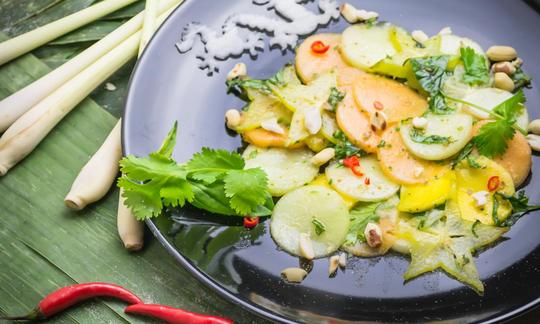Fruity Carpaccio with Melon, Mango, and Carambola
vegan
Ingredients (for servings, )
| For the dressing | |
|---|---|
| ¼ tsp | Cumin, seeds (raw, organic?) (0.02 oz) |
| ½ tsp | Real coriander, seeds (raw?, organic?) (0.03 oz) |
| ½ tsp, whole | Fennel seeds, raw (organic?) (0.04 oz) |
| 1 stalk | Lemongrass, West Indian or Guatemalan lemongrass (0.88 oz) |
| ½ | Chili peppers, red, raw (organic?) (0.09 oz) |
| 6 leaves | Green mint, raw (organic?) (0.03 oz) |
| 6 leaves | Horapa, raw (Thai basil, organic?) (0.11 oz) |
| 10 leaves | Coriander leaves, raw (0.05 oz) |
| 1 | Limes, raw (organic?) (2.4 oz) |
| 2 tbsp | Agave syrup (agave syrup, raw?, organic?) (0.82 oz) |
| 2 tbsp | Walnut oil (cold pressed?, raw?, organic?) (0.96 oz) |
| For the carpaccio | |
| 1 | Mango, raw (organic?) (12 oz) |
| 2 ½ oz | Cantaloupe melons, raw (organic?) |
| 1 | Star fruit (carambola), raw (organic?) (3.2 oz) |
| 2 ½ oz | Honeydew melon, raw (organic?) |
| 2 ½ oz | Watermelons, raw (organic?) |
| For garnishing | |
| 4 tbsp, whole | Peanuts (raw?, organic?) (1.7 oz) |
Equipment
- grater
- mortar
- skillet (frying pan)
- stove
- citrus juicer (lemon squeezer)
Type of preparation
- cook
- chop or grind
- squeeze
- dry roast
- meld
- grate (shred)
- marinate
Preparation
For the dressing
Toast the cumin, coriander, and fennel seeds in a dry pan until fragrant. Finely crush using a mortar and pestle.Finely grate the bottom third of the lemongrass and finely chop the chili. Cut the herbs into thin strips. Zest the lime and squeeze 3 tablespoons of juice. Add all other ingredients for the dressing and mix well.
The amount of ingredients listed makes two servings of carpaccio.
We have intentionally reduced the amount of agave syrup from 3 tablespoons to 2 tablespoons. If you like your food sweeter, you can increase the amount.
For the carpaccio
Peel the mango, cantaloupe, honeydew melon, and watermelon and wash the carambola. Cut everything into thin slices and cover with the dressing. Allow the flavors to meld for a few minutes.Preparing the garnish
In the meantime, toast the peanuts in a dry pan, tossing regularly until light brown. Coarsely chop.Serving
Arrange the pieces of sliced fruit on a plate in a fan shape. Sprinkle the roasted peanuts on top and serve.
|
Nutritional Information per person
Convert per 100g
|
2000 kcal | |
|---|---|---|
| Energy | 470 kcal | 23.5% |
| Fat/Lipids | 27 g | 38.3% |
| Saturated Fats | 3.0 g | 14.9% |
| Carbohydrates (inc.dietary fiber) | 57 g | 21.2% |
| Sugars | 42 g | 47.0% |
| Fiber | 8.2 g | 32.8% |
| Protein/Albumin | 9.5 g | 19.0% |
| Cooking Salt (Na:22.7 mg) | 58 mg | 2.4% |
| Essential micronutrients with the highest proportions | per person | 2000 kcal | |
|---|---|---|---|
| Min | Copper, Cu | 6.4 mg | 641.0% |
| Vit | Vitamin C (ascorbic acid) | 113 mg | 142.0% |
| Fat | Linoleic acid; LA; 18:2 omega-6 | 11 g | 111.0% |
| Vit | Vitamin B9, B11 (Folate, as the active form of folic acid) | 168 µg | 84.0% |
| Fat | Alpha-Linolenic acid; ALA; 18:3 omega-3 | 1.6 g | 78.0% |
| Min | Manganese, Mn | 1.4 mg | 68.0% |
| Elem | Potassium, K | 882 mg | 44.0% |
| Prot | Tryptophan (Trp, W) | 0.09 g | 38.0% |
| Prot | Threonine (Thr, T, irreversibly transaminated) | 0.31 g | 33.0% |
| Vit | Vitamin E, as a-TEs | 3.9 mg | 33.0% |
Detailed Nutritional Information per Person for this Recipe
The majority of the nutritional information comes from the USDA (US Department of Agriculture). This means that the information for natural products is often incomplete or only given within broader categories, whereas in most cases products made from these have more complete information displayed.
If we take flaxseed, for example, the important essential amino acid ALA (omega-3) is only included in an overarching category whereas for flaxseed oil ALA is listed specifically. In time, we will be able to change this, but it will require a lot of work. An “i” appears behind ingredients that have been adjusted and an explanation appears when you hover over this symbol.
For Erb Muesli, the original calculations resulted in 48 % of the daily requirement of ALA — but with the correction, we see that the muesli actually covers >100 % of the necessary recommendation for the omega-3 fatty acid ALA. Our goal is to eventually be able to compare the nutritional value of our recipes with those that are used in conventional western lifestyles.
| Essential fatty acids | per person | 2000 kcal |
|---|---|---|
| Linoleic acid; LA; 18:2 omega-6 | 11 g | 111.0% |
| Alpha-Linolenic acid; ALA; 18:3 omega-3 | 1.6 g | 78.0% |
| Essential amino acids | per person | 2000 kcal |
|---|---|---|
| Tryptophan (Trp, W) | 0.09 g | 38.0% |
| Threonine (Thr, T, irreversibly transaminated) | 0.31 g | 33.0% |
| Phenylalanine (Phe, F) | 0.42 g | 27.0% |
| Isoleucine (Ile, I) | 0.31 g | 25.0% |
| Valin (Val, V) | 0.38 g | 24.0% |
| Leucine (Leu, L) | 0.55 g | 23.0% |
| Lysine (Lys, K, irreversibly transaminated) | 0.42 g | 22.0% |
| Methionine (Met, M) | 0.11 g | 12.0% |
| Vitamins | per person | 2000 kcal |
|---|---|---|
| Vitamin C (ascorbic acid) | 113 mg | 142.0% |
| Vitamin B9, B11 (Folate, as the active form of folic acid) | 168 µg | 84.0% |
| Vitamin E, as a-TEs | 3.9 mg | 33.0% |
| Vitamin B3 (Niacin) | 5.0 mg | 31.0% |
| Vitamin B6 (pyridoxine) | 0.43 mg | 31.0% |
| Vitamin K | 22 µg | 30.0% |
| Vitamin B1 (Thiamine) | 0.29 mg | 26.0% |
| Vitamin A, as RAE | 172 µg | 21.0% |
| Vitamin B5 (Pantothenic acid) | 1.2 mg | 20.0% |
| Vitamin B7 (Biotin, ex vitamin H) | 8.2 µg | 16.0% |
| Vitamin B2 (Riboflavin) | 0.17 mg | 12.0% |
| Essential macroelements (macronutrients) | per person | 2000 kcal |
|---|---|---|
| Potassium, K | 882 mg | 44.0% |
| Magnesium, Mg | 89 mg | 24.0% |
| Phosphorus, P | 158 mg | 23.0% |
| Calcium, Ca | 85 mg | 11.0% |
| Sodium, Na | 23 mg | 3.0% |
| Essential trace elements (micronutrients) | per person | 2000 kcal |
|---|---|---|
| Copper, Cu | 6.4 mg | 641.0% |
| Manganese, Mn | 1.4 mg | 68.0% |
| Iron, Fe | 3.3 mg | 24.0% |
| Zinc, Zn | 1.5 mg | 15.0% |
| Selenium, Se | 4.1 µg | 7.0% |
| Iod, I (Jod, J) | 3.1 µg | 2.0% |
| Fluorine, F | 0.88 µg | < 0.1% |
"Vegan quick quick - simply brilliant - brilliantly simple" includes innovative restaurant-quality dishes that you can prepare quickly and easily.
Since this book is written in German, a description is omitted here. If you are interested, please switch to German in the menu.
This fruity and light carpaccio with melon, mango, and carambola is delicious when served with a flavorsome Thai dressing.
Cantaloupe: The cantaloupe is one of the sweetest melons. Its rind is greenish beige and has a ridged and indented surface with a netted pattern. It has soft, bright orange flesh and a sweet taste. Cantaloupe is rich in fiber, vitamin C, and beta-carotene. Once you have cut open a cantaloupe, you should eat it as quickly as possible because the rind may contain salmonella.
Honeydew melon: The honeydew melon is closely related to the cantaloupe. It has a long, oval shape and smooth, yellow skin. Its flesh is light green and it has a sweet flavor.
Carambolas: Also known as star fruit, carambolas originally came from Southeast Asia and are now cultivated throughout the world in the tropics and subtropics. They are botanically a berry and have an oblong to oval shape and five vertical ribs and grooves. Carambolas have yellowish translucent flesh and a sweet, slightly tangy flavor. Carambolas are 90 % water and contain a lot of vitamins A and C, calcium, and iron.
Cumin: Although they have a similar name in many languages (e.g., in German: Kreuzkümmel and Kümmel), cumin and caraway come under a different genus and are actually not related. In addition, the two spices have a very different flavor.
Coriander seeds: Coriander seeds are spherical and have a tart-spicy to sweet-aromatic flavor. The seeds are often ground and used as a spice. Coriander seeds taste particularly savory if they are first toasted briefly and then ground or crushed using a mortar and pestle.
Lemongrass: Lemongrass gets its lemony flavor from the essential oils it contains, for example, citral. The lower parts of the stalks are mainly used in cooking as this is the fresher, juicier part of the stalk.
Thai basil: Thai basil, also known as horapa, is a type of basil that is native to Southeast Asia and used in a wide range of Asian dishes. Unlike its European counterpart, Thai basil has purple stems and blossoms and narrow, arrow-shaped leaves. The flavor is much different than “normal” basil and can be described as an anise- and licorice-like, slightly spicy flavor.
How to tell that a melon is ripe: You can tell that a melon is ripe from its strong smell. If you press on the rind it should be slightly soft or springy.
Cilantro (fresh coriander): Some people react to its intensive, slightly soapy aroma of fresh coriander with symptoms ranging from aversion to nausea. According to Swiss statistics, 15 % of the allergic population reacts to cilantro. If you prefer, it is fine to simply omit this ingredient. There is no alternative that has a similar flavor. Flat-leaf parsley may look like cilantro, but it has a completely different flavor.
Reducing the number of ingredients: You can also prepare the carpaccio with only two types of melons.
Raw vegan alternative: If you want to prepare a raw vegan carpaccio, don’t toast the seeds and the peanuts. Toasting is associated with a loss of flavor. Agave syrup is, strictly speaking, not a raw food as it is heated during processing to convert the polysaccharides it contains (mainly inulin) into simple sugars. However, if you buy agave syrup that is labeled “raw,” it should not have been heated to temperatures above 45 °C during processing. It is best to set your own limits regarding what you consider raw in a raw food diet.




